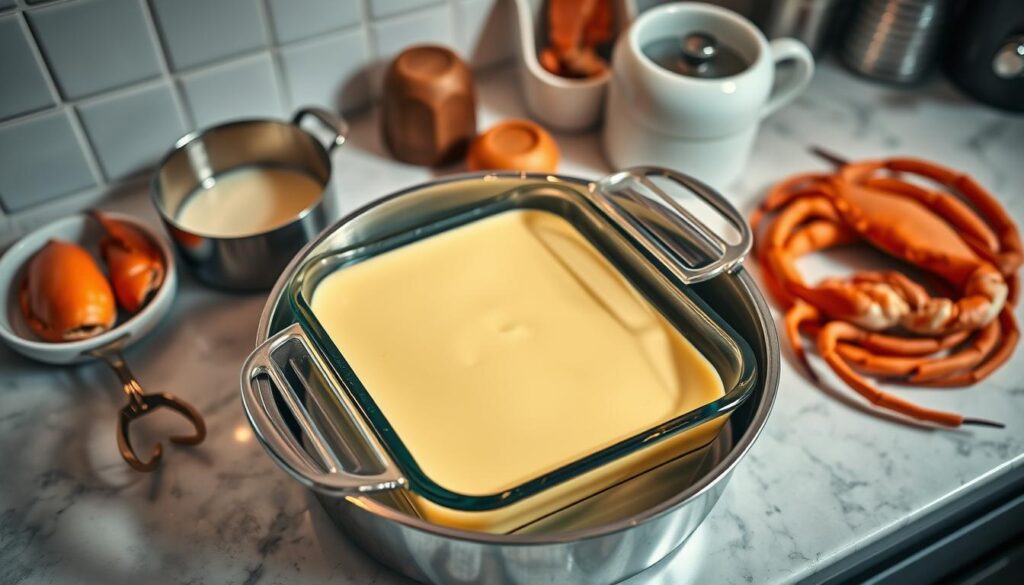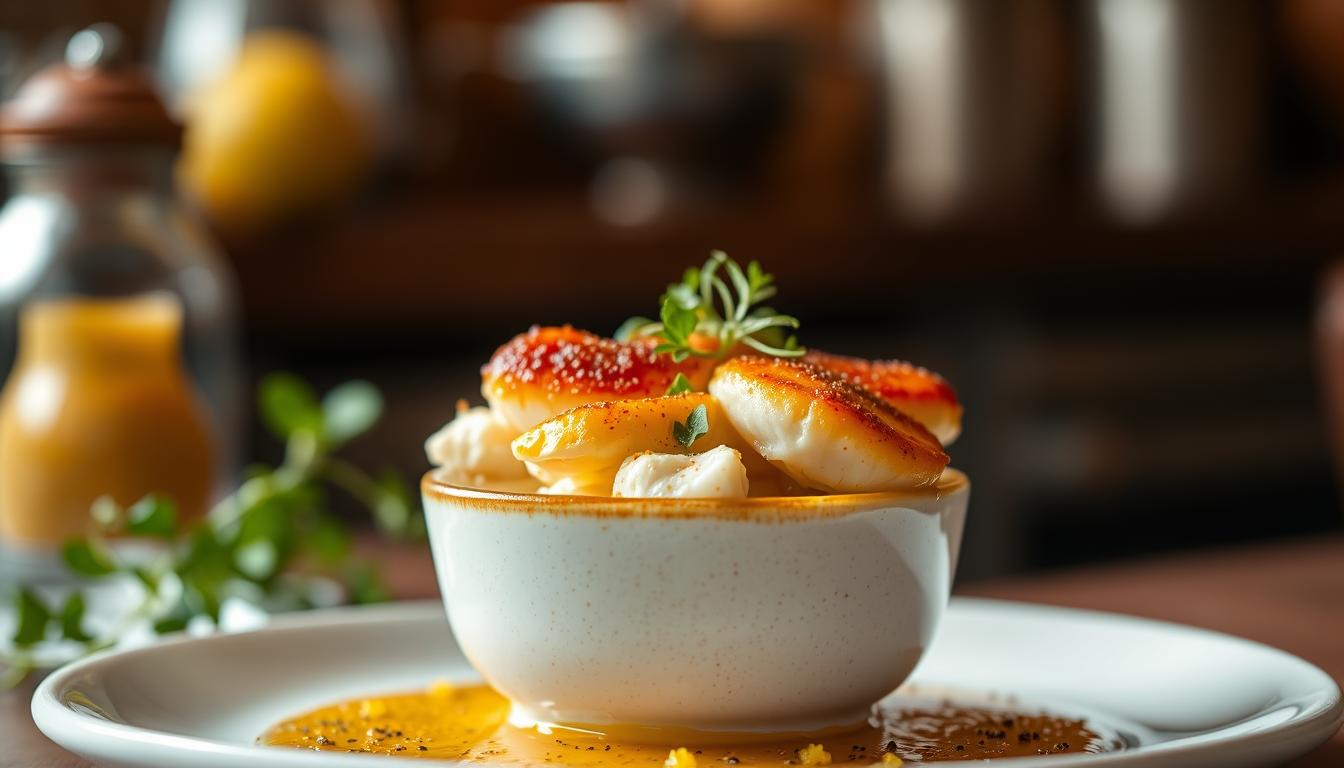- Welcome to the ultimate guide to creating an unforgettable crab brûlée recipe! This savory twist on the classic crème brûlée blends the delicate sweetness of fresh crab meat with a rich, creamy custard base, topped with a crackling caramelized sugar crust. Ideal for dinner parties or special occasions, this low-carb gourmet dish is sure to impress your guests.
When you crack the caramelized sugar, the scent of sweet crab and custard fills the room. Your guests are excited, eager to taste it. This creme brulee recipe is more than a meal; it’s a memorable experience.
Making this dish is like creating a work of art. It combines fresh crab’s sweetness with creamy custard’s richness. The result is a luxurious, yet light, low-carb appetizer. Prepare for a culinary journey that changes how you see seafood and French cuisine.
Table of Contents
Key Takeaways
- Fresh crab meat is essential for the best flavor and texture
- Egg yolks create the rich, creamy custard base
- Water bath technique ensures even cooking and silky texture
- Precision in sugar caramelization is crucial for the perfect crack
- Proper temperature control is key throughout the cooking process
- High-quality ingredients and equipment are vital for success
- Presentation and garnishing elevate the dish to restaurant quality
Introduction to Savory Crab Brûlée
Crab Brûlée is a gourmet seafood dish that turns the classic crème brûlée recipe into something new. It mixes creamy custard with the sweetness of fresh crab meat. This dish is great for dinner parties or fancy brunches.
Origins of French-Inspired Seafood Fusion
This dish likely started in coastal areas where seafood is plentiful. Upscale restaurants first brought it to the table as a mix of French cooking and local seafood. It’s a perfect blend of land and sea, offering a new seafood experience.
The Evolution of Classic Crème Brûlée
While traditional crème brûlée is sweet, Crab Brûlée goes savory. It keeps the caramelized sugar topping but swaps the sweet custard for a savory one. This change shows how French cooking can create new, exciting dishes.
What Makes This Dish Special
Crab Brûlée is special because of its mix of textures and tastes. The creamy custard, crunchy sugar, and tender crab make it a treat for the senses. It’s great as an appetizer or main course, fitting many dining events.
| Component | Description | Cooking Time |
|---|---|---|
| Custard Base | Heavy cream, egg yolks, sugar, salt | 30-35 minutes at 325°F |
| Crab Meat | Fresh lump or backfin crab | Pre-cooked |
| Sugar Topping | Granulated sugar | Torched before serving |
Essential Ingredients and Equipment
Making the perfect crab brûlée needs top-notch ingredients and the right kitchen tools. Let’s look at what you’ll need to make this fancy dish.
Key Ingredients
You’ll need fresh lump crab meat, like blue or Dungeness, for a tasty crab brûlée. The custard base requires egg yolks, heavy cream, and sugar. Here’s a list of the main ingredients:
- 3 cups heavy cream
- 8 egg yolks
- 1/2 cup sugar (100 grams)
- 1 vanilla bean pod
- 2-3 orange peels for added flavor
Essential Kitchen Equipment
Choosing the right crab meat is key, but so is having the right tools. Here’s what you’ll need:
| Equipment | Purpose |
|---|---|
| Ramekins (8 x 6-ounce) | Individual serving dishes |
| Baking dish | For water bath cooking |
| Fine-mesh strainer | Smooth custard texture |
| Mixing bowls | Ingredient preparation |
| Kitchen torch | Caramelizing sugar topping |
| Instant-read thermometer | Temperature control |
Make sure your custard doesn’t go over 170°F (77°C). Heat your oven to 325°F for the best results. With these ingredients and tools, you’re ready to make a crab brûlée that will wow anyone.
Selecting the Perfect Crab Meat
Choosing the right crab meat is key for your Crab Brûlée. The quality of your crab can make or break this dish. Let’s look at how to pick the best crab for your recipe.
Fresh vs. Lump Crab Comparison
Fresh crab meat tastes delicate but needs more prep. Lump crab meat is pre-cooked and ready to go. For the best taste, choose fresh, high-quality crab. Stay away from imitation crab.
| Type | Taste | Prep Time | Availability |
|---|---|---|---|
| Fresh Crab | Delicate, sweet | High | Spring to Fall |
| Lump Crab | Rich, ready-to-eat | Low | Year-round |
Storage and Handling Tips
Keep your crab meat in the fridge and use it within 24 hours for the best flavor. Handle it gently to keep its texture. For the purest taste, flake the crab with your fingers instead of tools.
Quality Indicators for Crab Selection
Look for crab meat that smells sweet and fresh. It should be moist but not watery. Check for any shell pieces and remove them. High-quality lump crab meat will have large, intact pieces. For your Crab Brûlée, you’ll need about 1 cup of crab meat to serve four people.
“The secret to a perfect Crab Brûlée lies in the quality of your crab. Choose wisely, and your dish will shine.”
Crab Brûlée Recipe
Want to make a gourmet seafood dish that’s both elegant and easy? This savory crab recipe is a twist on the classic creme brulee. It combines rich flavors and textures. It’s perfect for impressing guests or treating yourself to a special meal.
First, preheat your oven to 300°F. In a bowl, mix 400 ml of single cream, 2 large egg yolks, and 1 whole egg. Add 1/2 tablespoon of finely chopped pickled ginger, 1 finely chopped garlic clove, and 2 tablespoons of grated parmesan cheese for extra flavor. Whisk until well blended.
Put 150 grams of fresh crab meat in your ramekins. Pour the cream mixture over the crab, filling each ramekin about 3/4 full. Place the ramekins in a water bath and bake for 45 to 60 minutes. The custard should be set but still slightly jiggly in the center.
| Preparation Time | Cooking Time | Total Time | Servings |
|---|---|---|---|
| 25 minutes | 40 minutes | 1 hour 5 minutes | 4 |
After baking, let it cool completely for at least a few hours, preferably overnight. Before serving, sprinkle a thin layer of sugar on top. Caramelize with a kitchen torch for that crispy, golden finish. Serve at room temperature for the best flavor and texture.
This easy creme brulee recipe with a savory twist has a rich, creamy texture and unique flavor. With 536 calories per serving, it’s a decadent treat perfect for special occasions or when you’re craving a gourmet seafood dish that’s sure to impress.
The Art of Custard Base Creation
Making the perfect custard base is key for your crab brûlée. This delicate process needs precision and detail. Let’s explore the techniques to improve your custard.
Temperature Control Techniques
Mastering temperature control is crucial for the right creme brulee consistency. Preheat your oven to 325°F for the custard base. Use a water bath for even heating and to prevent curdling.
An instant-read thermometer is your best friend here. Aim for an internal temperature of 170-175°F for a silky-smooth texture.
Achieving the Perfect Consistency
To make a luxurious custard base, mix 6 large egg yolks with 450 ml of heavy cream. Whisk gently to avoid air bubbles. Strain the mixture through a fine-mesh sieve to remove lumps.
Common Custard Mistakes to Avoid
Steer clear of these common mistakes for perfect custard:
- Overcooking: Look for a slight jiggle in the center when gently shaking the ramekins.
- Uneven heating: Rotate your ramekins halfway through baking for consistent results.
- Rushed cooling: Allow your custards to cool gradually to prevent a grainy texture.
| Ingredient | Quantity | Purpose |
|---|---|---|
| Lump crab meat | 290 grams | Main protein |
| Large egg yolks | 6 | Custard base |
| Heavy cream | 450 ml | Custard base |
| Light brown sugar | 4 tablespoons | Caramelized topping |
Remember, patience is your ally in creating the perfect custard base. With these techniques, you’ll master the art of crab brûlée and impress your guests with a gourmet delight.
Mastering the Water Bath Method

Water bath cooking is a game-changer for your crab brûlée. It ensures even heat, making the custard silky-smooth. To set it up, place filled ramekins in a baking dish. Then, pour hot water halfway up the sides.
This method prevents curdling and cracking. It keeps the heat gentle and consistent. Watch the water levels while baking. Add more hot water if needed to keep the custard at the right temperature.
| Water Bath Tips | Benefits |
|---|---|
| Use hot water | Speeds up cooking process |
| Fill halfway up ramekins | Prevents water from splashing into custard |
| Monitor water levels | Ensures consistent temperature |
| Bake at 325°F (163°C) | Achieves ideal custard consistency |
For the best results, bake your crab brûlée at 325°F (163°C) for 25-30 minutes. This temperature cooks the custard slowly and evenly. It creates a velvety base that complements the crab meat’s sweetness perfectly.
Pro tip: To test if your custard is done, gently shake the ramekin. It should jiggle slightly in the center but be set around the edges.
Mastering the water bath method will take your crab brûlée to new heights. This technique is crucial for achieving the perfect balance of flavors and textures in your gourmet seafood dessert.
The Science of Caramelization
Caramelization is key to a great crab brûlée. It turns sugar into a golden, crispy layer on top of creamy custard. Let’s explore the sweet science behind this technique.
Sugar Selection Guide
For the best brûlée topping, use regular granulated sugar. It melts evenly and creates a signature crackle. Sprinkle about 2 tablespoons per ramekin on a dry custard surface.
This ensures a thin, even layer of caramelized sugar. It breaks with a satisfying crunch.
Torching Techniques
Mastering torch techniques is crucial for the perfect brûlée. Hold your kitchen torch about 6 inches from the sugar-coated custard. Move in circular motions to avoid burning and create an even caramel.
For an extra-crisp top, try double-caramelizing. Let the first layer cool, then add a second thin layer of sugar and torch again.
Achieving the Perfect Crack
The hallmark of a great brûlée is that satisfying crack when you break through the caramel. After torching, let the caramelized sugar set for 1-2 minutes. This cooling period allows the sugar to harden, creating that sought-after crispy texture.
Room temperature custards caramelize better than cold ones. So, let your crab brûlée sit out for about 30 minutes before torching.
| Caramelization Tips | Benefits |
|---|---|
| Use room temperature custard | Even caramelization |
| Double-caramelize | Extra-crisp top |
| Let caramel set | Perfect crack |
With these tips, you’ll create a crab brûlée with a perfectly caramelized top. The contrast between the crispy sugar and the creamy crab custard makes every bite a delight.
Presentation and Plating Tips
Make your crab brûlée stand out with fancy plating. The secret to great presentation is in the little things. Start by picking elegant, oven-safe ramekins that serve as both baking and serving dishes. This keeps the dish warm and adds class to your table.
Garnishing Suggestions
Boost your crab brûlée’s look with smart garnishes. Sprinkle chopped chives on top for color and taste. Add a lemon zest twist for brightness. For a fancy touch, place an edible flower beside each dish.
Serving Temperature Guidelines
For the best taste, serve your crab brûlée at room temperature. Let it cool for 10 minutes after caramelizing the sugar. This step makes the top crispy and the custard creamy.
For serving, pair it with crispy breadsticks or herbed crackers for texture. A light vinaigrette salad on the side can cut the richness. Remember, presentation is about pleasing the eyes and taste buds.
Wine Pairing and Serving Suggestions

Take your gourmet dining to the next level with the perfect wine for your crab brûlée. This dish is a hit when paired with the right wine. It brings out the crab’s delicate flavors and the creamy texture.
For a classic choice, go for a crisp white wine. Sauvignon Blanc or Pinot Grigio pairs well with sweet crab meat. Their acidity refreshes your taste buds between bites.
For a richer taste, try a lightly oaked Chardonnay. Its buttery notes blend with the custard. The subtle oak adds depth to the dish.
| Wine | Flavor Profile | Pairing Notes |
|---|---|---|
| Sauvignon Blanc | Crisp, citrusy | Cuts through richness |
| Pinot Grigio | Light, refreshing | Enhances crab sweetness |
| Chardonnay | Buttery, oaky | Complements custard |
| Champagne | Bubbly, dry | Adds elegance |
Serve your crab brûlée as a stunning starter or a light main dish. Pair it with a small mixed green salad or a slice of crusty bread. This balances the rich flavors. Always serve the wine chilled for the best gourmet dining experience.
Troubleshooting Common Issues
Mastering crab brûlée can be tricky, but with the right tips, you’ll get it right every time. Let’s tackle some common problems and their fixes.
Texture Problems and Solutions
A silky-smooth custard is essential for a great crab brûlée. If it’s grainy or curdled, it might be because it was overcooked or the temperature changed too fast. To fix this, bake in a water bath at 300°F (150°C). Bake for 40-45 minutes, then cool for 15 minutes before chilling.
Temperature-Related Challenges
Getting the temperature right is key for perfect crab brûlée. Use an oven thermometer to check your oven’s temperature. When caramelizing the sugar, hold the torch 2-3 inches away for an even crust.
| Issue | Solution |
|---|---|
| Runny custard | Increase baking time by 5-minute intervals |
| Overcooked custard | Reduce oven temperature to 275°F |
| Uneven caramelization | Rotate ramekins while torching |
Storage and Make-Ahead Tips
For make-ahead desserts, prepare crab brûlée up to 48 hours in advance. Keep it in the fridge, covered with plastic wrap. Caramelize the sugar just before serving for that perfect crack. Freezing can ruin the texture, so it’s best to avoid it.
By following these tips, you’ll be ready to tackle any crab brûlée challenges. This ensures a delicious and impressive dessert every time.
Recipe Variations and Adaptations
Crab recipe variations open up a world of culinary creativity. You can try different crab meats to change the taste of your brûlée. Dungeness, king, and snow crab each add their own flavor and texture.
For a fancy twist, swap crab for lobster or shrimp. These seafoods bring new tastes while keeping the recipe’s heart. Adding herbs like tarragon or dill to the custard can also boost the dish’s aroma.
Looking for dairy-free options? Coconut cream can replace heavy cream in the custard. This change not only fits dietary needs but also adds a tropical flavor to your dessert.
Feel bold? Try savory twists on classic desserts. A seafood panna cotta or a crab and cheese bread pudding can be a hit. These dishes mix appetizer and dessert, making your meal unforgettable.
- Use lump crab meat for best texture and flavor
- Experiment with breadcrumbs and Parmesan cheese for a crispy topping
- Try baking at 375°F (190°C) for 20-25 minutes
- Pair with a side salad or crusty bread for a complete meal
The secret to great crab brûlée variations is keeping flavors balanced. Don’t overcook the crab to keep it tender. Rotate the baking dish for even heat and a perfect caramelized top.
Conclusion
Crab brûlée is a gourmet seafood recipe that combines French techniques with coastal flavors. It turns 150 grams of crab meat into a luxurious dish, great for impressing guests. The mix of 400 ml cream, eggs, and seasonings makes a rich custard that showcases the crab’s taste.
Start by preheating the oven to 300°F. Bake the crab brûlée in a water bath for 45 to 60 minutes. This makes the texture silky-smooth. After baking, chill it for at least 2 hours to set.
For the final step, sprinkle sugar on top and caramelize it. This adds a crisp layer. To make it look great, add fresh chives, lemon zest, or edible flowers.
Enjoy it with a crisp Sauvignon Blanc or Pinot Grigio. These wines complement its creamy sweetness. With about 350 calories per serving, it’s a low-carb delight with 20 grams of protein. It’s a satisfying and sophisticated dish for your culinary collection.

